CQU MgMT20144: Annotated Bibliography on Business Contextual Factors
VerifiedAdded on 2023/06/10
|7
|1912
|144
Annotated Bibliography
AI Summary
This annotated bibliography examines the influence of contextual factors on business decision-making, drawing from five peer-reviewed journal articles. The introduction underscores the significance of these factors in shaping organizational choices. The first article explores organizational governance, highlighting the impact of governance structures on firm performance. The second article focuses on environmental forces, analyzing their effect on new ventures' competitive advantage. The third article delves into risks confronting firms, specifically examining the application of enterprise risk management. The fourth article discusses organizational and business practices, focusing on disability identity in the workplace. The final article investigates the functions of diverse firms, emphasizing the relationship between racial diversity and firm performance. The conclusion stresses the importance of considering these contextual factors for improved organizational performance, recommending diversity as a key factor for success.
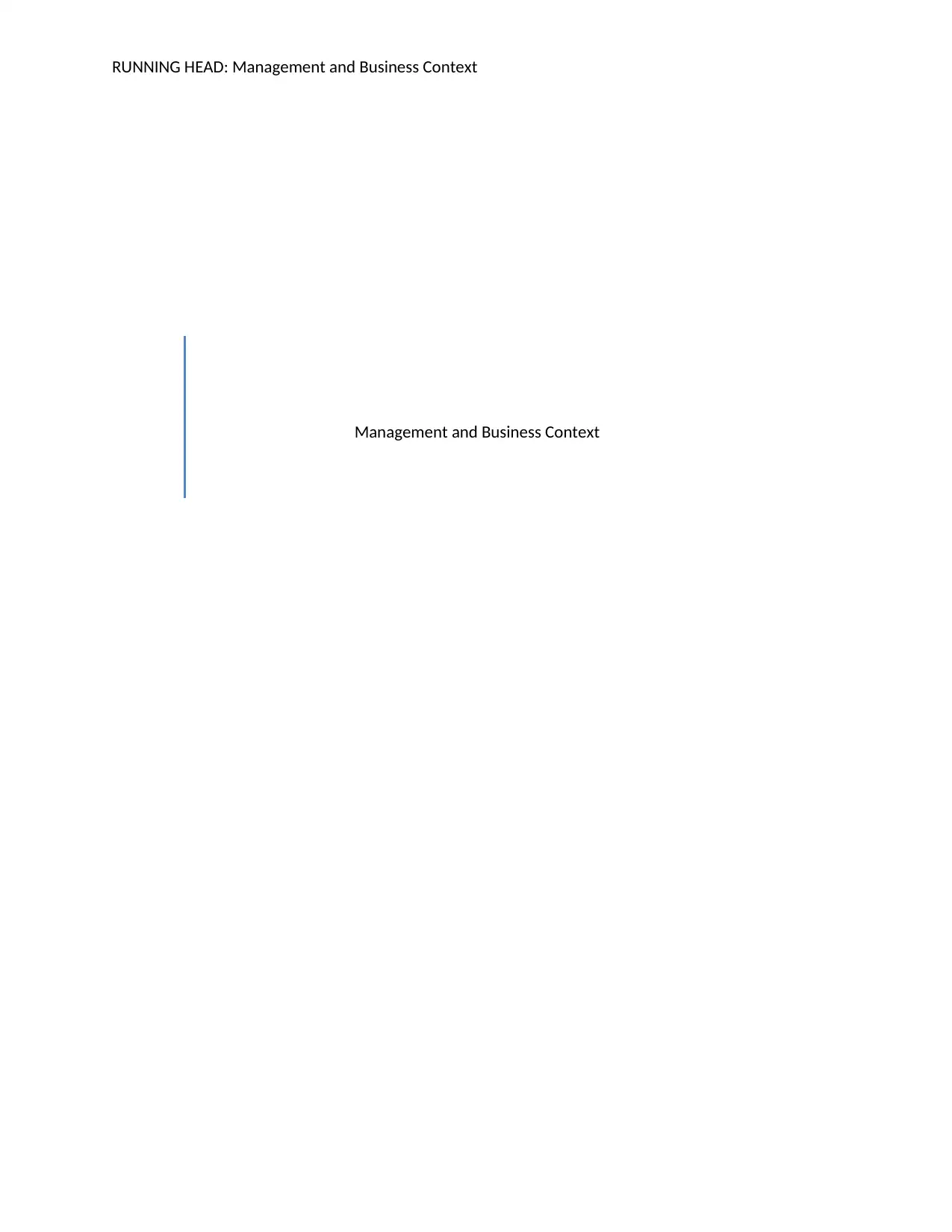
RUNNING HEAD: Management and Business Context
Management and Business Context
Management and Business Context
Paraphrase This Document
Need a fresh take? Get an instant paraphrase of this document with our AI Paraphraser
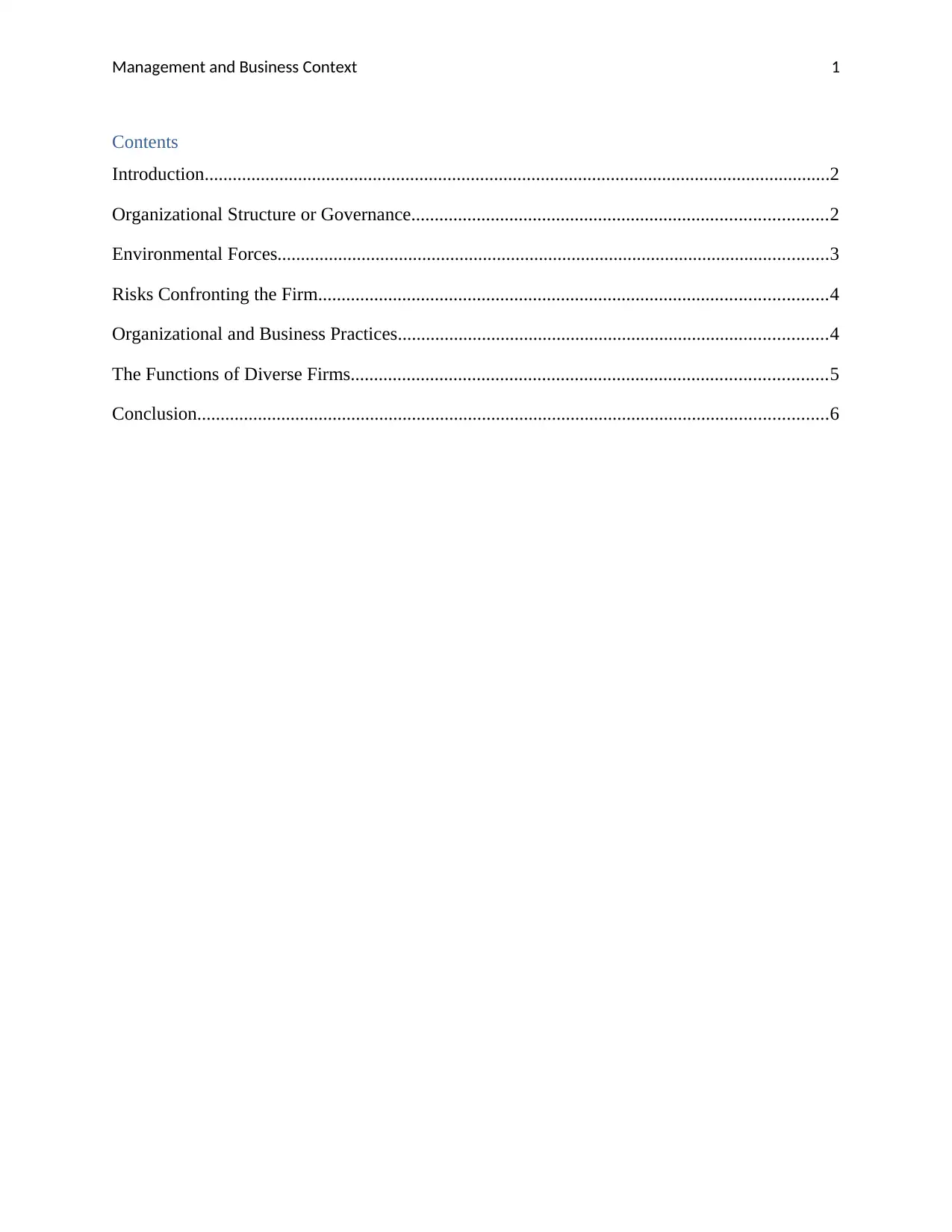
Management and Business Context 1
Contents
Introduction......................................................................................................................................2
Organizational Structure or Governance.........................................................................................2
Environmental Forces......................................................................................................................3
Risks Confronting the Firm.............................................................................................................4
Organizational and Business Practices............................................................................................4
The Functions of Diverse Firms......................................................................................................5
Conclusion.......................................................................................................................................6
Contents
Introduction......................................................................................................................................2
Organizational Structure or Governance.........................................................................................2
Environmental Forces......................................................................................................................3
Risks Confronting the Firm.............................................................................................................4
Organizational and Business Practices............................................................................................4
The Functions of Diverse Firms......................................................................................................5
Conclusion.......................................................................................................................................6
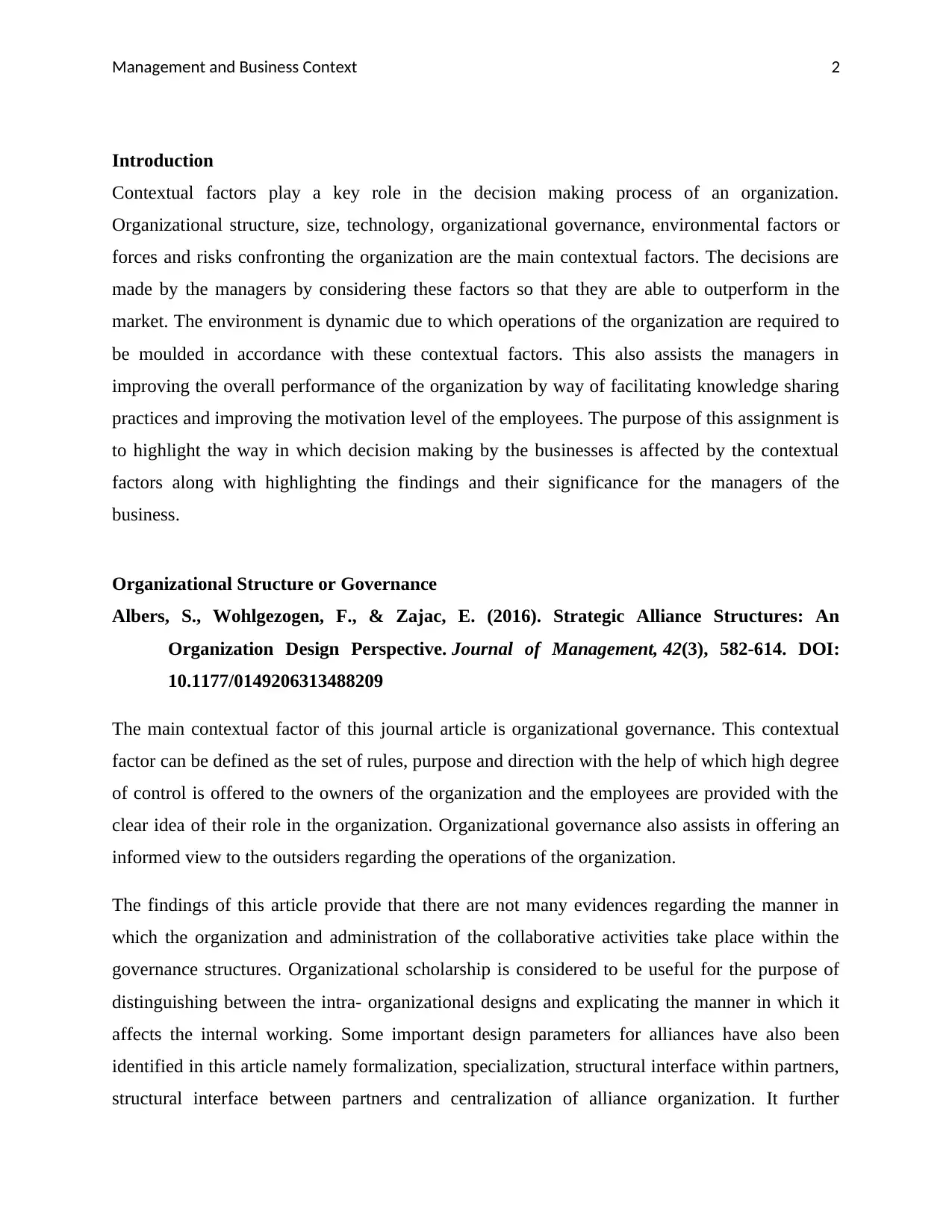
Management and Business Context 2
Introduction
Contextual factors play a key role in the decision making process of an organization.
Organizational structure, size, technology, organizational governance, environmental factors or
forces and risks confronting the organization are the main contextual factors. The decisions are
made by the managers by considering these factors so that they are able to outperform in the
market. The environment is dynamic due to which operations of the organization are required to
be moulded in accordance with these contextual factors. This also assists the managers in
improving the overall performance of the organization by way of facilitating knowledge sharing
practices and improving the motivation level of the employees. The purpose of this assignment is
to highlight the way in which decision making by the businesses is affected by the contextual
factors along with highlighting the findings and their significance for the managers of the
business.
Organizational Structure or Governance
Albers, S., Wohlgezogen, F., & Zajac, E. (2016). Strategic Alliance Structures: An
Organization Design Perspective. Journal of Management, 42(3), 582-614. DOI:
10.1177/0149206313488209
The main contextual factor of this journal article is organizational governance. This contextual
factor can be defined as the set of rules, purpose and direction with the help of which high degree
of control is offered to the owners of the organization and the employees are provided with the
clear idea of their role in the organization. Organizational governance also assists in offering an
informed view to the outsiders regarding the operations of the organization.
The findings of this article provide that there are not many evidences regarding the manner in
which the organization and administration of the collaborative activities take place within the
governance structures. Organizational scholarship is considered to be useful for the purpose of
distinguishing between the intra- organizational designs and explicating the manner in which it
affects the internal working. Some important design parameters for alliances have also been
identified in this article namely formalization, specialization, structural interface within partners,
structural interface between partners and centralization of alliance organization. It further
Introduction
Contextual factors play a key role in the decision making process of an organization.
Organizational structure, size, technology, organizational governance, environmental factors or
forces and risks confronting the organization are the main contextual factors. The decisions are
made by the managers by considering these factors so that they are able to outperform in the
market. The environment is dynamic due to which operations of the organization are required to
be moulded in accordance with these contextual factors. This also assists the managers in
improving the overall performance of the organization by way of facilitating knowledge sharing
practices and improving the motivation level of the employees. The purpose of this assignment is
to highlight the way in which decision making by the businesses is affected by the contextual
factors along with highlighting the findings and their significance for the managers of the
business.
Organizational Structure or Governance
Albers, S., Wohlgezogen, F., & Zajac, E. (2016). Strategic Alliance Structures: An
Organization Design Perspective. Journal of Management, 42(3), 582-614. DOI:
10.1177/0149206313488209
The main contextual factor of this journal article is organizational governance. This contextual
factor can be defined as the set of rules, purpose and direction with the help of which high degree
of control is offered to the owners of the organization and the employees are provided with the
clear idea of their role in the organization. Organizational governance also assists in offering an
informed view to the outsiders regarding the operations of the organization.
The findings of this article provide that there are not many evidences regarding the manner in
which the organization and administration of the collaborative activities take place within the
governance structures. Organizational scholarship is considered to be useful for the purpose of
distinguishing between the intra- organizational designs and explicating the manner in which it
affects the internal working. Some important design parameters for alliances have also been
identified in this article namely formalization, specialization, structural interface within partners,
structural interface between partners and centralization of alliance organization. It further
⊘ This is a preview!⊘
Do you want full access?
Subscribe today to unlock all pages.

Trusted by 1+ million students worldwide
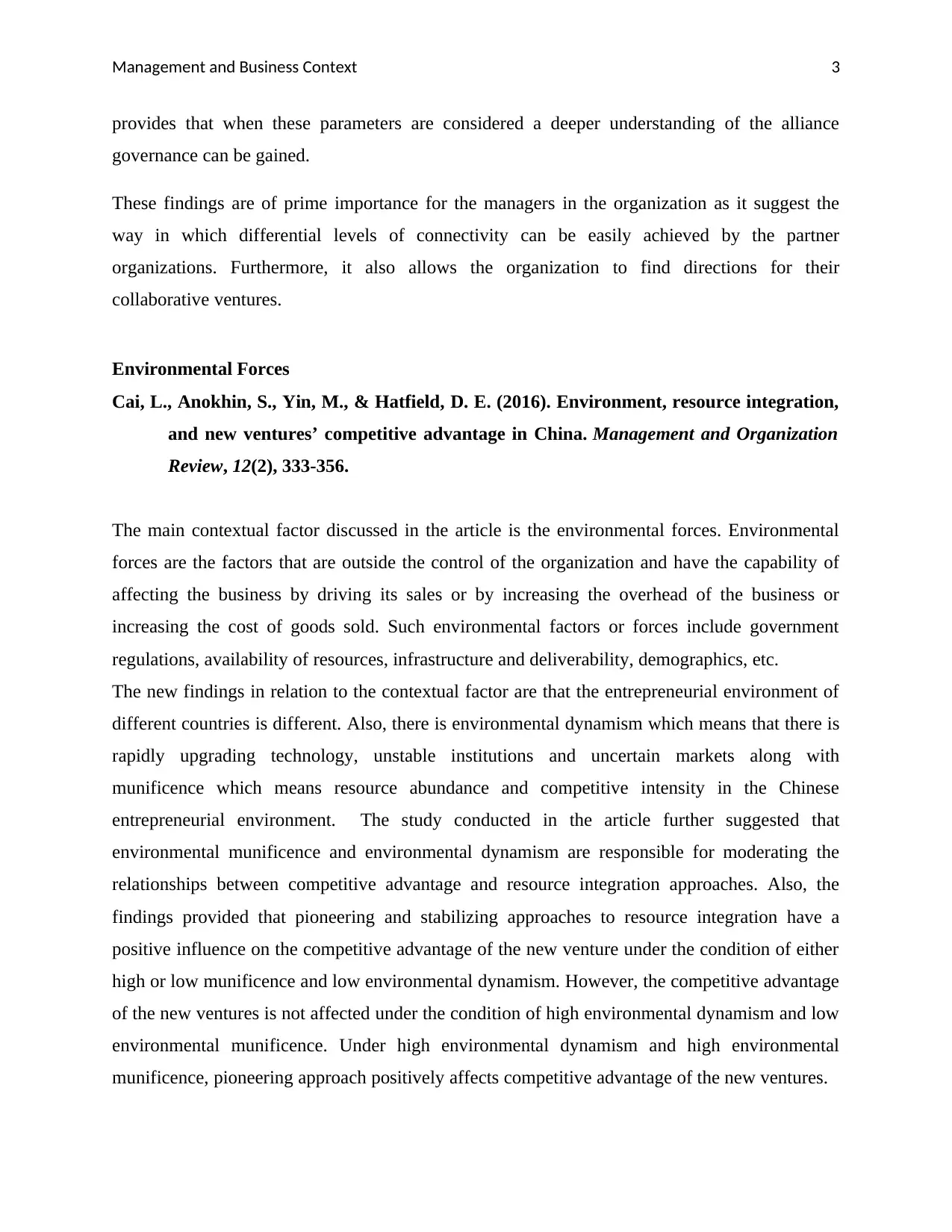
Management and Business Context 3
provides that when these parameters are considered a deeper understanding of the alliance
governance can be gained.
These findings are of prime importance for the managers in the organization as it suggest the
way in which differential levels of connectivity can be easily achieved by the partner
organizations. Furthermore, it also allows the organization to find directions for their
collaborative ventures.
Environmental Forces
Cai, L., Anokhin, S., Yin, M., & Hatfield, D. E. (2016). Environment, resource integration,
and new ventures’ competitive advantage in China. Management and Organization
Review, 12(2), 333-356.
The main contextual factor discussed in the article is the environmental forces. Environmental
forces are the factors that are outside the control of the organization and have the capability of
affecting the business by driving its sales or by increasing the overhead of the business or
increasing the cost of goods sold. Such environmental factors or forces include government
regulations, availability of resources, infrastructure and deliverability, demographics, etc.
The new findings in relation to the contextual factor are that the entrepreneurial environment of
different countries is different. Also, there is environmental dynamism which means that there is
rapidly upgrading technology, unstable institutions and uncertain markets along with
munificence which means resource abundance and competitive intensity in the Chinese
entrepreneurial environment. The study conducted in the article further suggested that
environmental munificence and environmental dynamism are responsible for moderating the
relationships between competitive advantage and resource integration approaches. Also, the
findings provided that pioneering and stabilizing approaches to resource integration have a
positive influence on the competitive advantage of the new venture under the condition of either
high or low munificence and low environmental dynamism. However, the competitive advantage
of the new ventures is not affected under the condition of high environmental dynamism and low
environmental munificence. Under high environmental dynamism and high environmental
munificence, pioneering approach positively affects competitive advantage of the new ventures.
provides that when these parameters are considered a deeper understanding of the alliance
governance can be gained.
These findings are of prime importance for the managers in the organization as it suggest the
way in which differential levels of connectivity can be easily achieved by the partner
organizations. Furthermore, it also allows the organization to find directions for their
collaborative ventures.
Environmental Forces
Cai, L., Anokhin, S., Yin, M., & Hatfield, D. E. (2016). Environment, resource integration,
and new ventures’ competitive advantage in China. Management and Organization
Review, 12(2), 333-356.
The main contextual factor discussed in the article is the environmental forces. Environmental
forces are the factors that are outside the control of the organization and have the capability of
affecting the business by driving its sales or by increasing the overhead of the business or
increasing the cost of goods sold. Such environmental factors or forces include government
regulations, availability of resources, infrastructure and deliverability, demographics, etc.
The new findings in relation to the contextual factor are that the entrepreneurial environment of
different countries is different. Also, there is environmental dynamism which means that there is
rapidly upgrading technology, unstable institutions and uncertain markets along with
munificence which means resource abundance and competitive intensity in the Chinese
entrepreneurial environment. The study conducted in the article further suggested that
environmental munificence and environmental dynamism are responsible for moderating the
relationships between competitive advantage and resource integration approaches. Also, the
findings provided that pioneering and stabilizing approaches to resource integration have a
positive influence on the competitive advantage of the new venture under the condition of either
high or low munificence and low environmental dynamism. However, the competitive advantage
of the new ventures is not affected under the condition of high environmental dynamism and low
environmental munificence. Under high environmental dynamism and high environmental
munificence, pioneering approach positively affects competitive advantage of the new ventures.
Paraphrase This Document
Need a fresh take? Get an instant paraphrase of this document with our AI Paraphraser
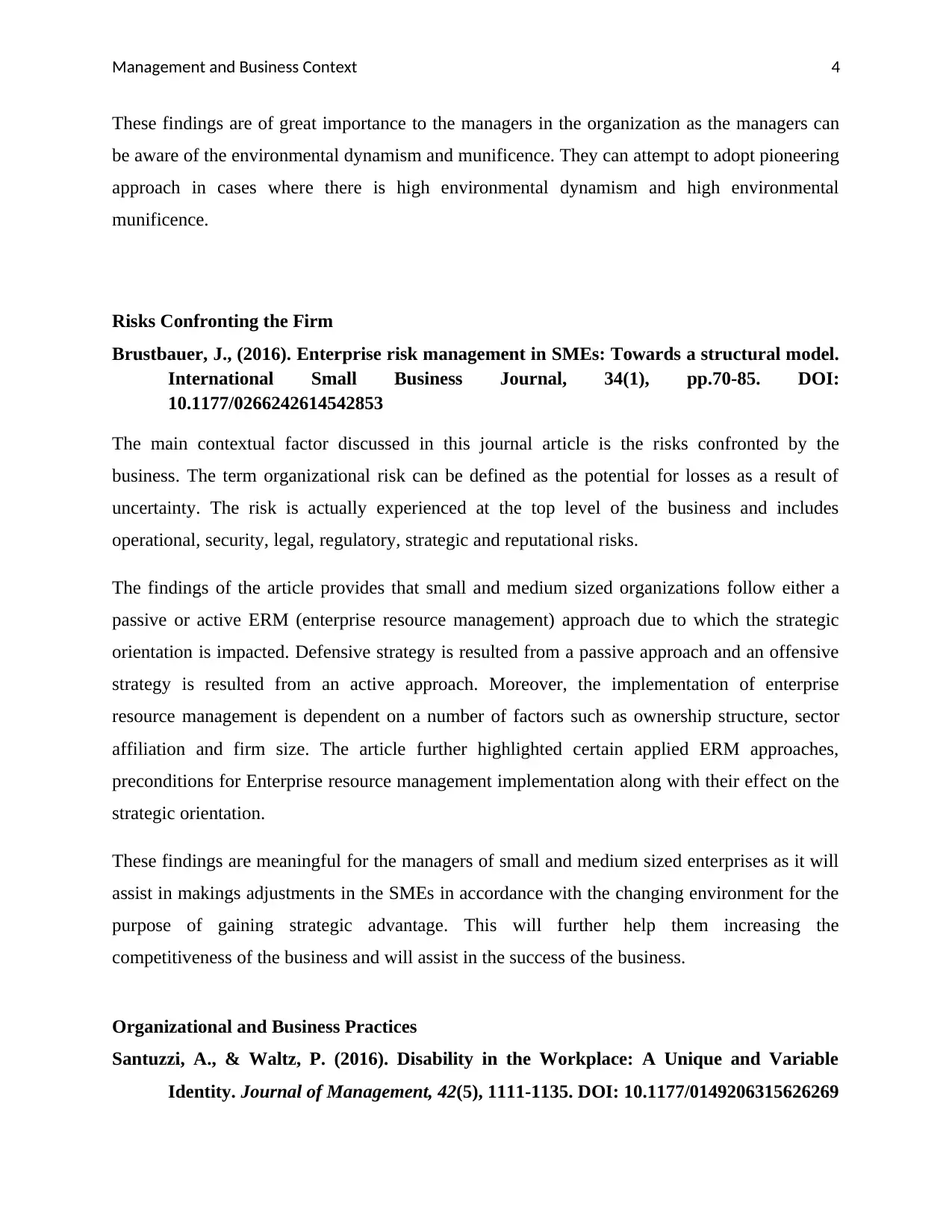
Management and Business Context 4
These findings are of great importance to the managers in the organization as the managers can
be aware of the environmental dynamism and munificence. They can attempt to adopt pioneering
approach in cases where there is high environmental dynamism and high environmental
munificence.
Risks Confronting the Firm
Brustbauer, J., (2016). Enterprise risk management in SMEs: Towards a structural model.
International Small Business Journal, 34(1), pp.70-85. DOI:
10.1177/0266242614542853
The main contextual factor discussed in this journal article is the risks confronted by the
business. The term organizational risk can be defined as the potential for losses as a result of
uncertainty. The risk is actually experienced at the top level of the business and includes
operational, security, legal, regulatory, strategic and reputational risks.
The findings of the article provides that small and medium sized organizations follow either a
passive or active ERM (enterprise resource management) approach due to which the strategic
orientation is impacted. Defensive strategy is resulted from a passive approach and an offensive
strategy is resulted from an active approach. Moreover, the implementation of enterprise
resource management is dependent on a number of factors such as ownership structure, sector
affiliation and firm size. The article further highlighted certain applied ERM approaches,
preconditions for Enterprise resource management implementation along with their effect on the
strategic orientation.
These findings are meaningful for the managers of small and medium sized enterprises as it will
assist in makings adjustments in the SMEs in accordance with the changing environment for the
purpose of gaining strategic advantage. This will further help them increasing the
competitiveness of the business and will assist in the success of the business.
Organizational and Business Practices
Santuzzi, A., & Waltz, P. (2016). Disability in the Workplace: A Unique and Variable
Identity. Journal of Management, 42(5), 1111-1135. DOI: 10.1177/0149206315626269
These findings are of great importance to the managers in the organization as the managers can
be aware of the environmental dynamism and munificence. They can attempt to adopt pioneering
approach in cases where there is high environmental dynamism and high environmental
munificence.
Risks Confronting the Firm
Brustbauer, J., (2016). Enterprise risk management in SMEs: Towards a structural model.
International Small Business Journal, 34(1), pp.70-85. DOI:
10.1177/0266242614542853
The main contextual factor discussed in this journal article is the risks confronted by the
business. The term organizational risk can be defined as the potential for losses as a result of
uncertainty. The risk is actually experienced at the top level of the business and includes
operational, security, legal, regulatory, strategic and reputational risks.
The findings of the article provides that small and medium sized organizations follow either a
passive or active ERM (enterprise resource management) approach due to which the strategic
orientation is impacted. Defensive strategy is resulted from a passive approach and an offensive
strategy is resulted from an active approach. Moreover, the implementation of enterprise
resource management is dependent on a number of factors such as ownership structure, sector
affiliation and firm size. The article further highlighted certain applied ERM approaches,
preconditions for Enterprise resource management implementation along with their effect on the
strategic orientation.
These findings are meaningful for the managers of small and medium sized enterprises as it will
assist in makings adjustments in the SMEs in accordance with the changing environment for the
purpose of gaining strategic advantage. This will further help them increasing the
competitiveness of the business and will assist in the success of the business.
Organizational and Business Practices
Santuzzi, A., & Waltz, P. (2016). Disability in the Workplace: A Unique and Variable
Identity. Journal of Management, 42(5), 1111-1135. DOI: 10.1177/0149206315626269
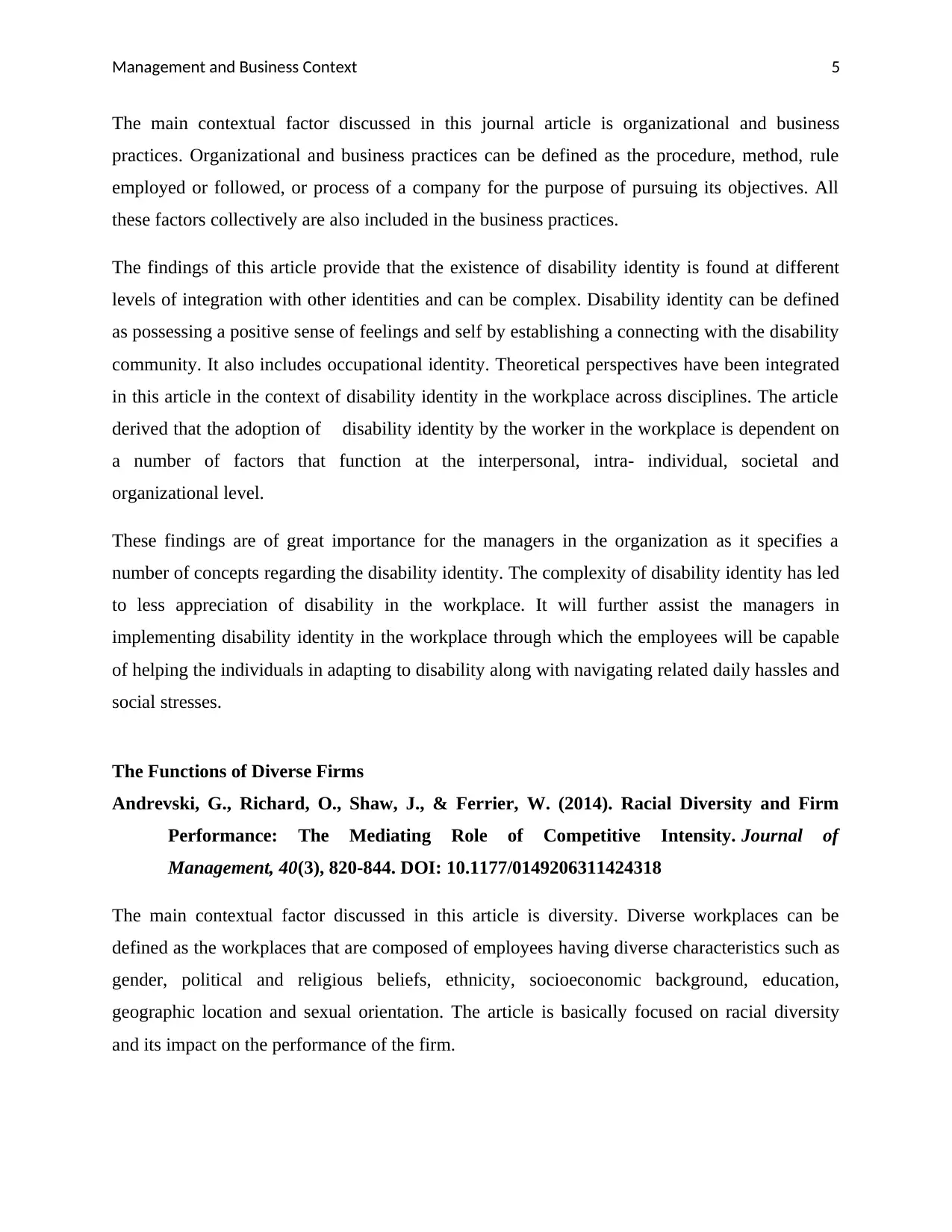
Management and Business Context 5
The main contextual factor discussed in this journal article is organizational and business
practices. Organizational and business practices can be defined as the procedure, method, rule
employed or followed, or process of a company for the purpose of pursuing its objectives. All
these factors collectively are also included in the business practices.
The findings of this article provide that the existence of disability identity is found at different
levels of integration with other identities and can be complex. Disability identity can be defined
as possessing a positive sense of feelings and self by establishing a connecting with the disability
community. It also includes occupational identity. Theoretical perspectives have been integrated
in this article in the context of disability identity in the workplace across disciplines. The article
derived that the adoption of disability identity by the worker in the workplace is dependent on
a number of factors that function at the interpersonal, intra- individual, societal and
organizational level.
These findings are of great importance for the managers in the organization as it specifies a
number of concepts regarding the disability identity. The complexity of disability identity has led
to less appreciation of disability in the workplace. It will further assist the managers in
implementing disability identity in the workplace through which the employees will be capable
of helping the individuals in adapting to disability along with navigating related daily hassles and
social stresses.
The Functions of Diverse Firms
Andrevski, G., Richard, O., Shaw, J., & Ferrier, W. (2014). Racial Diversity and Firm
Performance: The Mediating Role of Competitive Intensity. Journal of
Management, 40(3), 820-844. DOI: 10.1177/0149206311424318
The main contextual factor discussed in this article is diversity. Diverse workplaces can be
defined as the workplaces that are composed of employees having diverse characteristics such as
gender, political and religious beliefs, ethnicity, socioeconomic background, education,
geographic location and sexual orientation. The article is basically focused on racial diversity
and its impact on the performance of the firm.
The main contextual factor discussed in this journal article is organizational and business
practices. Organizational and business practices can be defined as the procedure, method, rule
employed or followed, or process of a company for the purpose of pursuing its objectives. All
these factors collectively are also included in the business practices.
The findings of this article provide that the existence of disability identity is found at different
levels of integration with other identities and can be complex. Disability identity can be defined
as possessing a positive sense of feelings and self by establishing a connecting with the disability
community. It also includes occupational identity. Theoretical perspectives have been integrated
in this article in the context of disability identity in the workplace across disciplines. The article
derived that the adoption of disability identity by the worker in the workplace is dependent on
a number of factors that function at the interpersonal, intra- individual, societal and
organizational level.
These findings are of great importance for the managers in the organization as it specifies a
number of concepts regarding the disability identity. The complexity of disability identity has led
to less appreciation of disability in the workplace. It will further assist the managers in
implementing disability identity in the workplace through which the employees will be capable
of helping the individuals in adapting to disability along with navigating related daily hassles and
social stresses.
The Functions of Diverse Firms
Andrevski, G., Richard, O., Shaw, J., & Ferrier, W. (2014). Racial Diversity and Firm
Performance: The Mediating Role of Competitive Intensity. Journal of
Management, 40(3), 820-844. DOI: 10.1177/0149206311424318
The main contextual factor discussed in this article is diversity. Diverse workplaces can be
defined as the workplaces that are composed of employees having diverse characteristics such as
gender, political and religious beliefs, ethnicity, socioeconomic background, education,
geographic location and sexual orientation. The article is basically focused on racial diversity
and its impact on the performance of the firm.
⊘ This is a preview!⊘
Do you want full access?
Subscribe today to unlock all pages.

Trusted by 1+ million students worldwide
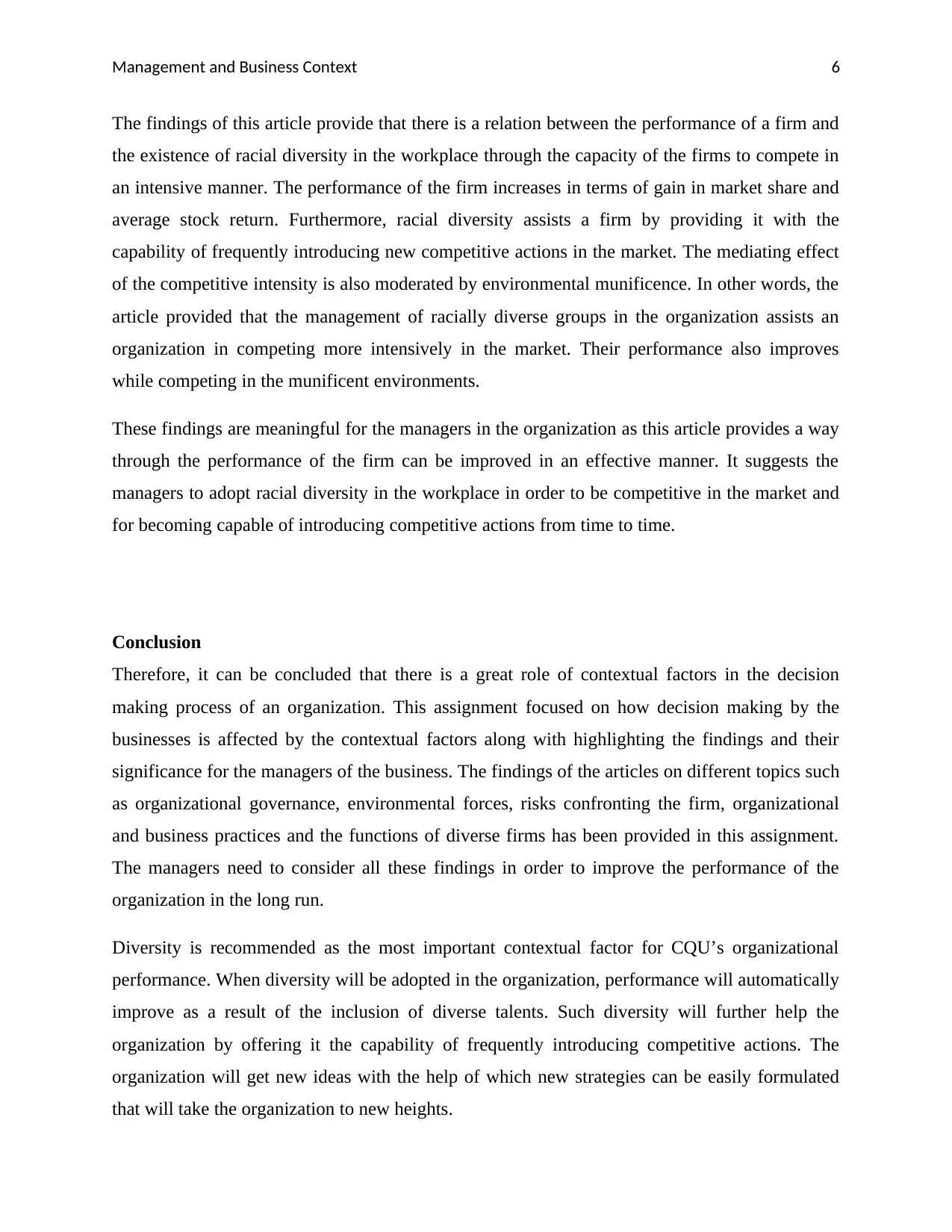
Management and Business Context 6
The findings of this article provide that there is a relation between the performance of a firm and
the existence of racial diversity in the workplace through the capacity of the firms to compete in
an intensive manner. The performance of the firm increases in terms of gain in market share and
average stock return. Furthermore, racial diversity assists a firm by providing it with the
capability of frequently introducing new competitive actions in the market. The mediating effect
of the competitive intensity is also moderated by environmental munificence. In other words, the
article provided that the management of racially diverse groups in the organization assists an
organization in competing more intensively in the market. Their performance also improves
while competing in the munificent environments.
These findings are meaningful for the managers in the organization as this article provides a way
through the performance of the firm can be improved in an effective manner. It suggests the
managers to adopt racial diversity in the workplace in order to be competitive in the market and
for becoming capable of introducing competitive actions from time to time.
Conclusion
Therefore, it can be concluded that there is a great role of contextual factors in the decision
making process of an organization. This assignment focused on how decision making by the
businesses is affected by the contextual factors along with highlighting the findings and their
significance for the managers of the business. The findings of the articles on different topics such
as organizational governance, environmental forces, risks confronting the firm, organizational
and business practices and the functions of diverse firms has been provided in this assignment.
The managers need to consider all these findings in order to improve the performance of the
organization in the long run.
Diversity is recommended as the most important contextual factor for CQU’s organizational
performance. When diversity will be adopted in the organization, performance will automatically
improve as a result of the inclusion of diverse talents. Such diversity will further help the
organization by offering it the capability of frequently introducing competitive actions. The
organization will get new ideas with the help of which new strategies can be easily formulated
that will take the organization to new heights.
The findings of this article provide that there is a relation between the performance of a firm and
the existence of racial diversity in the workplace through the capacity of the firms to compete in
an intensive manner. The performance of the firm increases in terms of gain in market share and
average stock return. Furthermore, racial diversity assists a firm by providing it with the
capability of frequently introducing new competitive actions in the market. The mediating effect
of the competitive intensity is also moderated by environmental munificence. In other words, the
article provided that the management of racially diverse groups in the organization assists an
organization in competing more intensively in the market. Their performance also improves
while competing in the munificent environments.
These findings are meaningful for the managers in the organization as this article provides a way
through the performance of the firm can be improved in an effective manner. It suggests the
managers to adopt racial diversity in the workplace in order to be competitive in the market and
for becoming capable of introducing competitive actions from time to time.
Conclusion
Therefore, it can be concluded that there is a great role of contextual factors in the decision
making process of an organization. This assignment focused on how decision making by the
businesses is affected by the contextual factors along with highlighting the findings and their
significance for the managers of the business. The findings of the articles on different topics such
as organizational governance, environmental forces, risks confronting the firm, organizational
and business practices and the functions of diverse firms has been provided in this assignment.
The managers need to consider all these findings in order to improve the performance of the
organization in the long run.
Diversity is recommended as the most important contextual factor for CQU’s organizational
performance. When diversity will be adopted in the organization, performance will automatically
improve as a result of the inclusion of diverse talents. Such diversity will further help the
organization by offering it the capability of frequently introducing competitive actions. The
organization will get new ideas with the help of which new strategies can be easily formulated
that will take the organization to new heights.
1 out of 7
Related Documents
Your All-in-One AI-Powered Toolkit for Academic Success.
+13062052269
info@desklib.com
Available 24*7 on WhatsApp / Email
![[object Object]](/_next/static/media/star-bottom.7253800d.svg)
Unlock your academic potential
Copyright © 2020–2025 A2Z Services. All Rights Reserved. Developed and managed by ZUCOL.



